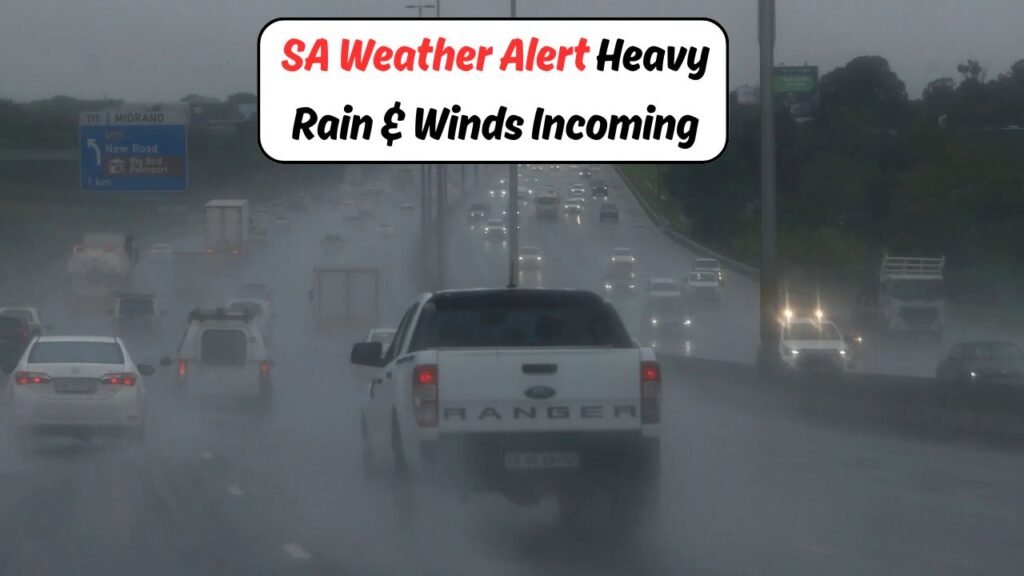South Africa Weather Alert – South Africa Weather Alert: Heavy Rain & Strong Winds Expected In THESE Regions — A powerful cold front and a deepening coastal low are forecast to drive widespread wet and windy conditions across several provinces over the next 48–72 hours. Communities along the southern and eastern coastline, as well as parts of the interior high ground, should prepare for periods of heavy downpours, localized flooding, and dangerous cross-winds on exposed routes. Coastal areas may see choppy seas, disruptive surf, and occasional storm surges near river mouths at high tide. Inland, gusts could lift debris, topple weak trees, and complicate travel on open stretches and mountain passes. Urban drainage networks could be overwhelmed during intense bursts of rain, leading to water pooling on low-lying roads, informal settlements, and underpasses. Motorists, commuters, and outdoor workers are advised to adjust plans, allow extra travel time, and keep emergency kits handy. Keep monitoring official alerts and heed instructions from municipal disaster management teams.

Affected Regions & Timing (Next 72 Hours)
The greatest risk window is expected to roll east and north as the system progresses. The southern Cape, Garden Route, and eastern interior are likely to be first in line for heavy showers and squalls, followed by stretches of the Wild Coast and KwaZulu-Natal coastline where onshore winds can funnel moisture and accelerate rainfall rates. Pockets of the Highveld—including parts of Gauteng, Mpumalanga, North West, and the Free State—may experience blustery conditions, sharp showers, and rapid temperature drops behind the frontal boundary. Communities near the Drakensberg foothills should watch for orographic enhancement that can intensify rainfall on windward slopes. The most intense periods often occur overnight into early morning, when visibility is poorer and roads are slickest. Rural routes with river crossings and gravel sections will be particularly vulnerable to washouts and quick rises in stream levels. Stay alert to hyper-local warnings, as timing can shift with small changes in wind direction and frontal speed.
Expected Impacts on Roads, Power & Coast
Short-duration cloudbursts can overwhelm storm drains, trigger rockfalls on steep cuttings, and reduce braking distances dramatically. Expect intermittent lane closures on mountain passes and coastal roads where wind gusts and spray impair visibility. Townships and low-lying suburbs that typically battle blocked drains should prepare for street flooding and seepage into ground-level rooms. Power disruptions are possible where saturated soils, strong gusts, or falling branches impact lines and transformers. Farmers should plan around wind damage to tunnels and netting, while small craft, anglers, and harbor operations must account for rough, confused seas and dangerous swells near breakwaters. Public transport schedules could face delays; allow extra time and check service updates before departing. Construction sites should secure scaffolding, sheeting, and cranes ahead of the strongest winds. If traveling long distances, identify alternate routes, keep fuel levels high, and inform family of expected arrival times in case of network congestion after storms.
Safety Guidance & Who Should Be Extra Cautious
Residents in flood-prone neighborhoods, informal settlements near rivers or stormwater channels, and communities with a history of landslip activity should prioritize early precautions. Keep important documents sealed and elevated; move electronics and valuables off the floor; and prepare sandbags or barriers for doorways if you have them available. Parents and caregivers should avoid sending children across low-level bridges or shortcuts that may be submerged during peak runoff. Shift nonessential travel away from the heaviest rain bands, and never drive through water of unknown depth—most vehicles lose traction quickly in fast-moving flows. Outdoor events, sporting fixtures, and hillside hikes should be postponed until conditions stabilize. For emergencies from a cellphone, you can dial 112 to reach help; otherwise, follow local municipal and disaster management channels for area-specific hotlines and shelters. Keep pets indoors, check neighbors who may need assistance, and charge power banks in case of temporary outages.
Preparation Checklist & What To Do If Conditions Worsen
Before the worst weather arrives, clear gutters, downpipes, and yard drains; tie down loose roofing sheets, tarps, and garden furniture; and park vehicles away from large trees and unstable walls. Stock basic supplies—potable water, non-perishable food, batteries, a flashlight, first-aid items—and refill essential medications. Save key contacts for insurers, roadside assistance, and local disaster management, and enable location sharing with family during travel. If forecasts escalate, relocate from flood-exposed rooms to higher levels, pre-position sandbags, and switch off nonessential appliances to limit surge damage. During heavy downpours, monitor river levels and leave early if evacuation routes are at risk of cutting off. Motorists should keep headlights on, maintain longer following distances, and watch for debris after strong gusts. After the storm, avoid wading through pooled water that may hide open manholes, report damaged infrastructure promptly, and photograph impacts safely for claims once conditions allow.




